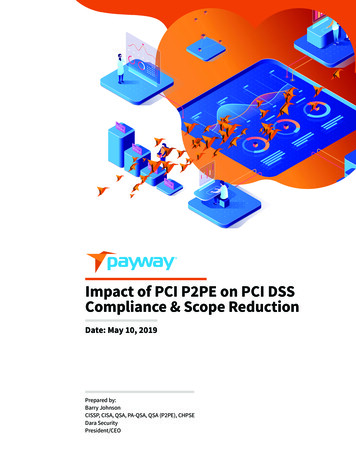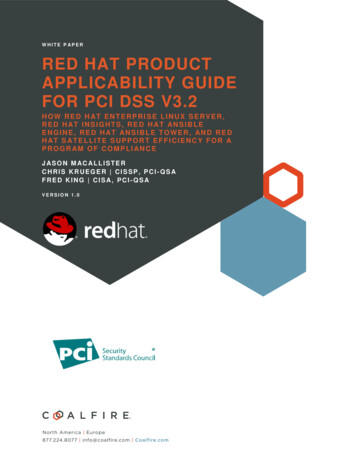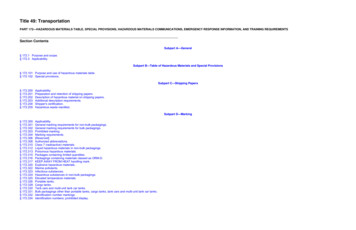
Transcription
Title 49: TransportationPART 172—HAZARDOUS MATERIALS TABLE, SPECIAL PROVISIONS, HAZARDOUS MATERIALS COMMUNICATIONS, EMERGENCY RESPONSE INFORMATION, AND TRAINING REQUIREMENTSSection ContentsSubpart A—General§ 172.1 Purpose and scope.§ 172.3 Applicability.Subpart B—Table of Hazardous Materials and Special Provisions§ 172.101 Purpose and use of hazardous materials table.§ 172.102 Special provisions.Subpart C—Shipping Papers§ 172.200§ 172.201§ 172.202§ 172.203§ 172.204§ 172.205Applicability.Preparation and retention of shipping papers.Description of hazardous material on shipping papers.Additional description requirements.Shipper's certification.Hazardous waste manifest.Subpart D—Marking§ 172.300§ 172.301§ 172.302§ 172.303§ 172.304§ 172.306§ 172.308§ 172.310§ 172.312§ 172.313§ 172.315§ 172.316§ 172.317§ 172.320§ 172.322§ 172.323§ 172.324§ 172.325§ 172.326§ 172.328§ 172.330§ 172.331§ 172.332§ 172.334Applicability.General marking requirements for non-bulk packagings.General marking requirements for bulk packagings.Prohibited marking.Marking requirements.[Reserved]Authorized abbreviations.Class 7 (radioactive) materials.Liquid hazardous materials in non-bulk packagings.Poisonous hazardous materials.Packages containing limited quantities.Packagings containing materials classed as ORM-D.KEEP AWAY FROM HEAT handling mark.Explosive hazardous materials.Marine pollutants.Infectious substances.Hazardous substances in non-bulk packagings.Elevated temperature materials.Portable tanks.Cargo tanks.Tank cars and multi-unit tank car tanks.Bulk packagings other than portable tanks, cargo tanks, tank cars and multi-unit tank car tanks.Identification number markings.Identification numbers; prohibited display.
§ 172.336 Identification numbers; special provisions.§ 172.338 Replacement of identification numbers.Subpart E—Labeling§ 172.400 General labeling requirements.§ 172.400a Exceptions from labeling.§ 172.401 Prohibited labeling.§ 172.402 Additional labeling requirements.§ 172.403 Class 7 (radioactive) material.§ 172.404 Labels for mixed and consolidated packaging.§ 172.405 Authorized label modifications.§ 172.406 Placement of labels.§ 172.407 Label specifications.§ 172.411 EXPLOSIVE 1.1, 1.2, 1.3, 1.4, 1.5 and 1.6 labels, and EXPLOSIVE Subsidiary label.§ 172.415 NON-FLAMMABLE GAS label.§ 172.416 POISON GAS label.§ 172.417 FLAMMABLE GAS label.§ 172.419 FLAMMABLE LIQUID label.§ 172.420 FLAMMABLE SOLID label.§ 172.422 SPONTANEOUSLY COMBUSTIBLE label.§ 172.423 DANGEROUS WHEN WET label.§ 172.426 OXIDIZER label.§ 172.427 ORGANIC PEROXIDE label.§ 172.429 POISON INHALATION HAZARD label.§ 172.430 POISON label.§ 172.431 [Reserved]§ 172.432 INFECTIOUS SUBSTANCE label.§ 172.436 RADIOACTIVE WHITE-I label.§ 172.438 RADIOACTIVE YELLOW-II label.§ 172.440 RADIOACTIVE YELLOW-III label.§ 172.441 FISSILE label.§ 172.442 CORROSIVE label.§ 172.444 [Reserved]§ 172.446 CLASS 9 label.§ 172.448 CARGO AIRCRAFT ONLY label.§ 172.450 EMPTY label.Subpart F—Placarding§ 172.500§ 172.502§ 172.503§ 172.504§ 172.505§ 172.506§ 172.507§ 172.508§ 172.510§ 172.512§ 172.514§ 172.516§ 172.519§ 172.521§ 172.522Applicability of placarding requirements.Prohibited and permissive placarding.Identification number display on placards.General placarding requirements.Placarding for subsidiary hazards.Providing and affixing placards: Highway.Special placarding provisions: Highway.Placarding and affixing placards: Rail.Special placarding provisions: Rail.Freight containers and aircraft unit load devices.Bulk packagings.Visibility and display of placards.General specifications for placards.DANGEROUS placard.EXPLOSIVES 1.1, EXPLOSIVES 1.2 and EXPLOSIVES 1.3 placards.
§ 172.523§ 172.524§ 172.525§ 172.526§ 172.527§ 172.528§ 172.530§ 172.532§ 172.536§ 172.540§ 172.542§ 172.544§ 172.546§ 172.547§ 172.548§ 172.550§ 172.552§ 172.553§ 172.554§ 172.555§ 172.556§ 172.558§ 172.560EXPLOSIVES 1.4 placard.EXPLOSIVES 1.5 placard.EXPLOSIVES 1.6 placard.[Reserved]Background requirements for certain placards.NON-FLAMMABLE GAS placard.OXYGEN placard.FLAMMABLE GAS placard.[Reserved]POISON GAS placard.FLAMMABLE placard.COMBUSTIBLE placard.FLAMMABLE SOLID placard.SPONTANEOUSLY COMBUSTIBLE placard.DANGEROUS WHEN WET placard.OXIDIZER placard.ORGANIC PEROXIDE placard.[Reserved]POISON placard.POISON INHALATION HAZARD placard.RADIOACTIVE placard.CORROSIVE placard.CLASS 9 placard.Subpart G—Emergency Response Information§ 172.600§ 172.602§ 172.604§ 172.606Applicability and general requirements.Emergency response information.Emergency response telephone number.Carrier information contact.Subpart H—Training§ 172.700§ 172.701§ 172.702§ 172.704Purpose and scope.Federal-State relationship.Applicability and responsibility for training and testing.Training requirements.Subpart I—Security Plans§ 172.800 Purpose and applicability.§ 172.802 Components of a security plan.§ 172.804 Relationship to other Federal requirements.Appendix A to Part 172—Office of Hazardous Materials Transportation Color Tolerance Charts and TablesAppendix B to Part 172—Trefoil SymbolAppendix C to Part 172—Dimensional Specifications for Recommended Placard HolderAuthority: 49 U.S.C. 5101–5128, 44701; 49 CFR 1.53.Source: Amdt. 172–29, 41 FR 15996, Apr. 15, 1976, unless otherwise noted.
Subpart A—General§ 172.1 Purpose and scope.This part lists and classifies those materials which the Department has designated as hazardous materials for purposes of transportation and prescribes the requirements for shipping papers, packagemarking, labeling, and transport vehicle placarding applicable to the shipment and transportation of those hazardous materials.[Amdt. 172–29, 41 FR 15997, Apr. 15, 1976, as amended by 66 FR 45379, Aug. 28, 2001]§ 172.3 Applicability.(a) This part applies to—(1) Each person who offers a hazardous material for transportation, and(2) Each carrier by air, highway, rail, or water who transports a hazardous material.(b) When a person, other than one of those provided for in paragraph (a) of this section, performs a packaging labeling or marking function required by this part, that person shall perform the function inaccordance with this part.[Amdt. 172–29, 41 FR 15996, Apr. 15, 1976, as amended by Amdt. 172–32, 41 FR 38179, Sept. 9, 1976]Subpart B—Table of Hazardous Materials and Special Provisions§ 172.101 Purpose and use of hazardous materials table.(a) The Hazardous Materials Table (Table) in this section designates the materials listed therein as hazardous materials for the purpose of transportation of those materials. For each listed material, theTable identifies the hazard class or specifies that the material is forbidden in transportation, and gives the proper shipping name or directs the user to the preferred proper shipping name. In addition, theTable specifies or references requirements in this subchapter pertaining to labeling, packaging, quantity limits aboard aircraft and stowage of hazardous materials aboard vessels.(b) Column 1: Symbols. Column 1 of the Table contains six symbols (“ ”, “A”, “D”, “G”, “I” and “W”) as follows:(1) The plus ( ) sign fixes the proper shipping name, hazard class and packing group for that entry without regard to whether the material meets the definition of that class, packing group or any otherhazard class definition. When the plus sign is assigned to a proper shipping name in Column (1) of the §172.101 Table, it means that the material is known to pose a risk to humans. When a plus sign isassigned to mixtures or solutions containing a material where the hazard to humans is significantly different from that of the pure material or where no hazard to humans is posed, the material may be
described using an alternative shipping name that represents the hazards posed by the material. An appropriate alternate proper shipping name and hazard class may be authorized by the AssociateAdministrator.(2) The letter “A” denotes a material that is subject to the requirements of this subchapter only when offered or intended for transportation by aircraft, unless the material is a hazardous substance or ahazardous waste. A shipping description entry preceded by an “A” may be used to describe a material for other modes of transportation provided all applicable requirements for the entry are met.(3) The letter “D” identifies proper shipping names which are appropriate for describing materials for domestic transportation but may be inappropriate for international transportation under the provisions ofinternational regulations (e.g., IMO, ICAO). An alternate proper shipping name may be selected when either domestic or international transportation is involved.(4) The letter “G” identifies proper shipping names for which one or more technical names of the hazardous material must be entered in parentheses, in association with the basic description. (See§172.203(k).)(5) The letter “I” identifies proper shipping names which are appropriate for describing materials in international transportation. An alternate proper shipping name may be selected when only domestictransportation is involved.(6) The letter “W” denotes a material that is subject to the requirements of this subchapter only when offered or intended for transportation by vessel, unless the material is a hazardous substance or ahazardous waste. A shipping description entry preceded by a “W” may be used to describe a material for other modes of transportation provided all applicable requirements for the entry are met.(c) Column 2: Hazardous materials descriptions and proper shipping names. Column 2 lists the hazardous materials descriptions and proper shipping names of materials designated as hazardousmaterials. Modification of a proper shipping name may otherwise be required or authorized by this section. Proper shipping names are limited to those shown in Roman type (not italics).(1) Proper shipping names may be used in the singular or plural and in either capital or lower case letters. Words may be alternatively spelled in the same manner as they appear in the ICAO TechnicalInstructions or the IMDG Code. For example “aluminum” may be spelled “aluminium” and “sulfur” may be spelled “sulphur”. However, the word “inflammable” may not be used in place of the word“flammable”.(2) Punctuation marks and words in italics are not part of the proper shipping name, but may be used in addition to the proper shipping name. The word “or” in italics indicates that terms in the sequencemay be used as the proper shipping name, as appropriate.(3) The word “poison” or “poisonous” may be used interchangeably with the word “toxic” when only domestic transportation is involved. The abbreviation “n.o.i.” or “n.o.i.b.n.” may be used interchangeablywith “n.o.s.”.(4) Except for hazardous wastes, when qualifying words are used as part of the proper shipping name, their sequence in the package markings and shipping paper description is optional. However, theentry in the Table reflects the preferred sequence.(5) When one entry references another entry by use of the word “see”, if both names are in Roman type, either name may be used as the proper shipping name (e.g., Ethyl alcohol, see Ethanol).(6) When a proper shipping name includes a concentration range as part of the shipping description, the actual concentration, if it is within the range stated, may be used in place of the concentration range.For example, an aqueous solution of hydrogen peroxide containing 30 percent peroxide may be described as “Hydrogen peroxide, aqueous solution with not less than 20 percent but not more than 40percent hydrogen peroxide” or “Hydrogen peroxide, aqueous solution with 30 percent hydrogen peroxide”.(7) Use of the prefix “mono” is optional in any shipping name, when appropriate. Thus, Iodine monochloride may be used interchangeably with Iodine chloride. In “Glycerol alpha-monochlorohydrin” the term“mono” is considered a prefix to the term “chlorohydrin” and may be deleted.(8) Use of the word “liquid” or “solid”. The word “liquid” or “solid” may be added to a proper shipping name when a hazardous material specifically listed by name may, due to differing physical states, be aliquid or solid. When the packaging specified in Column 8 is inappropriate for the physical state of the material, the table provided in paragraph (i)(4) of this section should be used to determine theappropriate packaging section.
(9) Hazardous wastes. If the word “waste” is not included in the hazardous material description in Column 2 of the Table, the proper shipping name for a hazardous waste (as defined in §171.8 of thissubchapter), shall include the word “Waste” preceding the proper shipping name of the material. For example: Waste acetone.(10) Mixtures and solutions. (i) A mixture or solution not identified specifically by name, comprised of a hazardous material identified in the Table by technical name and non-hazardous material, shall bedescribed using the proper shipping name of the hazardous material and the qualifying word “mixture” or “solution”, as appropriate, unless—(A) Except as provided in §172.101(i)(4) the packaging specified in Column 8 is inappropriate to the physical state of the material;(B) The shipping description indicates that the proper shipping name applies only to the pure or technically pure hazardous material;(C) The hazard class, packing group, or subsidiary hazard of the mixture or solution is different from that specified for the entry;(D) There is a significant change in the measures to be taken in emergencies;(E) The material is identified by special provision in Column 7 of the §172.101 Table as a material poisonous by inhalation; however, it no longer meets the definition of poisonous by inhalation or it fallswithin a different hazard zone than that specified in the special provision; or(F) The material can be appropriately described by a shipping name that describes its intended application, such as “Coating solution”, “Extracts, flavoring” or “Compound, cleaning liquid”.(ii) If one or more of the conditions specified in paragraph (c)(10)(i) of this section is satisfied, then a proper shipping name shall be selected as prescribed in paragraph (c)(12)(ii) of this section.(iii) A mixture or solution not identified in the Table specifically by name, comprised of two or more hazardous materials in the same hazard class, shall be described using an appropriate shippingdescription (e.g., “Flammable liquid, n.o.s.”). The name that most appropriately describes the material shall be used; e.g., an alcohol not listed by its technical name in the Table shall be described as“Alcohol, n.o.s.” rather than “Flammable liquid, n.o.s.”. Some mixtures may be more appropriately described according to their application, such as “Coating solution” or “Extracts, flavoring liquid” rather thanby an n.o.s. entry. Under the provisions of subparts C and D of this part, the technical names of at least two components most predominately contributing to the hazards of the mixture or solution may berequired in association with the proper shipping name.(11) Except for a material subject to or prohibited by §173.21, 173.54, 173.56(d), 173.56(e), 173.224(c) or 173.225(b) of this subchapter, a material that is considered to be a hazardous waste or a sampleof a material for which the hazard class is uncertain and must be determined by testing may be assigned a tentative proper shipping name, hazard class, identification number and packing group, ifapplicable, based on the shipper's tentative determination according to:(i) Defining criteria in this subchapter;(ii) The hazard precedence prescribed in §173.2a of this subchapter;(iii) The shipper's knowledge of the material;(iv) In addition to paragraphs (c)(11)(i) through (iii) of this section, for a sample of a material other than a waste, the following must be met:(A) Except when the word “Sample” already appears in the proper shipping name, the word “Sample” must appear as part of the proper shipping name or in association with the basic description on theshipping paper.(B) When the proper shipping description for a sample is assigned a “G” in Column (1) of the §172.101 Table, and the primary constituent(s) for which the tentative classification is based are not known, theprovisions requiring a technical name for the constituent(s) do not apply; and
(C) A sample must be transported in a combination packaging that conforms to the requirements of this subchapter that are applicable to the tentative packing group assigned, and may not exceed a netmass of 2.5 kg (5.5 pounds) per package.Note to paragraph(c)(11): For the transportation of samples of self-reactive materials, organic peroxides, explosives or lighters, see §§173.224(c)(3), 173.225(c)(2), 173.56(d) or 173.308(b)(2) of this subchapter, respectively.(12) Except when the proper shipping name in the Table is preceded by a plus ( )—(i) If it is specifically determined that a material meets the definition of a hazard class, packing group or hazard zone, other than the class, packing group or hazard zone shown in association with the propershipping name, or does not meet the defining criteria for a subsidiary hazard shown in Column 6 of the Table, the material shall be described by an appropriate proper shipping name listed in associationwith the correct hazard class, packing group, hazard zone, or subsidiary hazard for the material.(ii) Generic or n.o.s. descriptions. If an appropriate technical name is not shown in the Table, selection of a proper shipping name shall be made from the generic or n.o.s. descriptions corresponding to thespecific hazard class, packing group, hazard zone, or subsidiary hazard, if any, for the material. The name that most appropriately describes the material shall be used; e.g., an alcohol not listed by itstechnical name in the Table shall be described as “Alcohol, n.o.s.” rather than “Flammable liquid, n.o.s.”. Some mixtures may be more appropriately described according to their application, such as“Coating solution” or “Extracts, flavoring, liquid”, rather than by an n.o.s. entry, such as “Flammable liquid, n.o.s.” It should be noted, however, that an n.o.s. description as a proper shipping name may notprovide sufficient information for shipping papers and package markings. Under the provisions of subparts C and D of this part, the technical name of one or more constituents which makes the product ahazardous material may be required in association with the proper shipping name.(iii) Multiple hazard materials. If a material meets the definition of more than one hazard class, and is not identified in the Table specifically by name (e.g., acetyl chloride), the hazard class of the materialshall be determined by using the precedence specified in §173.2a of this subchapter, and an appropriate shipping description (e.g., “Flammable liquid, corrosive n.o.s.”) shall be selected as described inparagraph (c)(12)(ii) of this section.(iv) If it is specifically determined that a material is not a forbidden material and does not meet the definition of any hazard class, the material is not a hazardous material.(13) Self-reactive materials and organic peroxides. A generic proper shipping name for a self-reactive material or an organic peroxide, as listed in Column 2 of the Table, must be selected based on thematerial's technical name and concentration, in accordance with the provisions of §§173.224 or 173.225 of this subchapter, respectively.(14) A proper shipping name that describes all isomers of a material may be used to identify any isomer of that material if the isomer meets criteria for the same hazard class or division, subsidiary risk(s)and packing group, unless the isomer is specifically identified in the Table.(15) Unless a hydrate is specifically listed in the Table, a proper shipping name for the equivalent anhydrous substance may be used, if the hydrate meets the same hazard class or division, subsidiaryrisk(s) and packing group.(16) Unless it is already included in the proper shipping name in the §172.101 Table, the qualifying words “liquid” or “solid” may be added in association with the proper shipping name when a hazardousmaterial specifically listed by name in the §172.101 Table may, due to the differing physical states of the various isomers of the material, be either a liquid or a solid (for example “Dinitrotoluenes, liquid” and“Dinitrotoluenes, solid”). Use of the words “liquid” or “solid” is subject to the limitations specified for the use of the words “mixture” or “solution” in paragraph (c)(10) of this section. The qualifying word“molten” may be added in association with the proper shipping name when a hazardous material, which is a solid in accordance with the definition in §171.8 of this subchapter, is offered for transportation inthe molten state (for example, “Alkylphenols, solid, n.o.s., molten”).(d) Column 3: Hazard class or Division. Column 3 contains a designation of the hazard class or division corresponding to each proper shipping name, or the word “Forbidden”.(1) A material for which the entry in this column is “Forbidden” may not be offered for transportation or transported. This prohibition does not apply if the material is diluted, stabilized or incorporated in adevice and it is classed in accordance with the definitions of hazardous materials contained in part 173 of this subchapter.(2) When a reevaluation of test data or new data indicates a need to modify the “Forbidden” designation or the hazard class or packing group specified for a material specifically identified in the Table, thisdata should be submitted to the Associate Administrator.
(3) A basic description of each hazard class and the section reference for class definitions appear in §173.2 of this subchapter.(4) Each reference to a Class 3 material is modified to read “Combustible liquid” when that material is reclassified in accordance with §173.150(e) or (f) of this subchapter or has a flash point above 60 C(140 F) but below 93 C (200 F).(e) Column 4: Identification number. Column 4 lists the identification number assigned to each proper shipping name. Those preceded by the letters “UN” are associated with proper shipping namesconsidered appropriate for international transportation as well as domestic transportation. Those preceded by the letters “NA” are associated with proper shipping names not recognized for internationaltransportation, except to and from Canada. Identification numbers in the “NA9000” series are associated with proper shipping names not appropriately covered by international hazardous materials(dangerous goods) transportation standards, or not appropriately addressed by international transportation standards for emergency response information purposes, except for transportation between theUnited States and Canada.(f) Column 5: Packing group. Column 5 specifies one or more packing groups assigned to a material corresponding to the proper shipping name and hazard class for that material. Class 2, Class 7, Division6.2 (other than regulated medical wastes), and ORM-D materials, do not have packing groups. Packing Groups I, II and III indicate the degree of danger presented by the material is either great, medium orminor, respectively. If more than one packing group is indicated for an entry, the packing group for the hazardous material is determined using the criteria for assignment of packing groups specified insubpart D of part 173. When a reevaluation of test data or new data indicates a need to modify the specified packing group(s), the data should be submitted to the Associate Administrator. Each referencein this column to a material which is a hazardous waste or a hazardous substance, and whose proper shipping name is preceded in Column 1 of the Table by the letter “A” or “W”, is modified to read “III” onthose occasions when the material is offered for transportation or transported by a mode in which its transportation is not otherwise subject to requirements of this subchapter.(g) Column 6: Labels. Column 6 specifies codes which represent the hazard warning labels required for a package filled with a material conforming to the associated hazard class and proper shippingname, unless the package is otherwise excepted from labeling by a provision in subpart E of this part, or part 173 of this subchapter. The first code is indicative of the primary hazard of the material.Additional label codes are indicative of subsidiary hazards. Provisions in §172.402 may require that a label other than that specified in Column 6 be affixed to the package in addition to that specified inColumn 6. No label is required for a material classed as a combustible liquid or for a Class 3 material that is reclassed as a combustible liquid. For “Empty” label requirements, see §173.428 of thissubchapter. The codes contained in Column 6 are defined according to the following table:Label Substitution TableLabel codeLabel name1Explosive1.11Explosive 1.111.21Explosive 1.211.31Explosive 1.311.41Explosive 1.411.51Explosive 1.511.61Explosive 1.612.1Flammable Gas2.2Non-Flammable Gas2.3Poison Gas3Flammable Liquid
4.1Flammable Solid4.2Spontaneously Combustible4.3Dangerous When Wet5.1Oxidizer5.2Organic Peroxide6.1 (inhalation hazard, Zone A or B)Poison Inhalation Hazard6.1 (other than inhalation hazard, Zone A or B)2Poison6.2Infectious substance7Radioactive8Corrosive9Class 91Refers to the appropriate compatibility group letter.2The packing group for a material is indicated in column 5 of the table.(h) Column 7: Special provisions. Column 7 specifies codes for special provisions applicable to hazardous materials. When Column 7 refers to a special provision for a hazardous material, the meaning andrequirements of that special provision are as set forth in §172.102 of this subpart.(i) Column 8: Packaging authorizations. Columns 8A, 8B and 8C specify the applicable sections for exceptions, non-bulk packaging requirements and bulk packaging requirements, respectively, in part 173of this subchapter. Columns 8A, 8B and 8C are completed in a manner which indicates that “§173.” precedes the designated numerical entry. For example, the entry “202” in Column 8B associated with theproper shipping name “Gasoline” indicates that for this material conformance to non-bulk packaging requirements prescribed in §173.202 of this subchapter is required. When packaging requirements arespecified, they are in addition to the standard requirements for all packagings prescribed in §173.24 of this subchapter and any other applicable requirements in subparts A and B of part 173 of thissubchapter.(1) Exceptions. Column 8A contains exceptions from some of the requirements of this subchapter. The referenced exceptions are in addition to those specified in subpart A of part 173 and elsewhere in thissubchapter. A “None” in this column means no packaging exceptions are authorized, except as may be provided by special provisions in Column 7.(2) Non-bulk packaging. Column 8B references the section in part 173 of this subchapter which prescribes packaging requirements for non-bulk packagings. A “None” in this column means non-bulkpackagings are not authorized, except as may be provided by special provisions in Column 7. Each reference in this column to a material which is a hazardous waste or a hazardous substance, and whoseproper shipping name is preceded in Column 1 of the Table by the letter “A” or “W”, is modified to include “§173.203” or “§173.213”, as appropriate for liquids and solids, respectively, on those occasionswhen the material is offered for transportation or transported by a mode in which its transportation is not otherwise subject to the requirements of this subchapter.(3) Bulk packaging. Column (8C) specifies the section in part 173 of this subchapter that prescribes packaging requirements for bulk packagings, subject to the limitations, requirements, and additionalauthorizations of Columns (7) and (8B). A “None” in Column (8C) means bulk packagings are not authorized, except as may be provided by special provisions in Column (7) and in packaging authorizationsColumn (8B). Additional authorizations and limitations for use of UN portable tanks are set forth in Column 7. For each reference in this column to a material that is a hazardous waste or a hazardoussubstance, and whose proper shipping name is preceded in Column 1 of the Table by the letter “A” or “W” and that is offered for transportation or transported by a mode in which its transportation is nototherwise subject to the requirements of this subchapter:
(4) For a hazardous material which is specifically named in the Table and whose packaging sections specify packagings not applicable to the form of the material (e.g., packaging specified is for solidmaterial and the material is being offered for transportation in a liquid form) the following table should be used to determine the appropriate packaging section:Packaging section reference for solid materialsCorresponding packaging section for liquid �173.242§173.243(5) Cylinders. For cylinders, both non-bulk and bulk packaging authorizations are set forth in Column (8B). Notwithstanding a designation of “None” in Column (8C), a bulk cylinder may be used whenspecified through the section reference in Column (8B).(j) Column 9: Quantity limitations. Columns 9A and 9B specify the maximum quantities that may be offered for transportation in one package by passenger-carrying aircraft or passenger-carrying rail car(Column 9A) or by cargo aircraft only (Column 9B), subject to the following:(1) “Forbidden” means the material may not be offered for transportation or transported in the applicable mode of transport.(2) The quantity limitation is “net” except where otherwise specified, such as for “Consumer commodity” which specifies “30 kg gross.”(3) When articles or devices are specifically listed by name, the net quantity li
Appendix A to Part 172—Office of Hazardous Materials Transportation Color Tolerance Charts and Tables Appendix B to Part 172—Trefoil Symbol Appendix C to Part 172—Dimensional Specifications for Recommended Placard Holder Authority: 49 U.S.C. 5101-5128, 44701; 49 CFR 1.53. Source: Amdt. 172-29, 41 FR 15996, Apr. 15, 1976, unless .
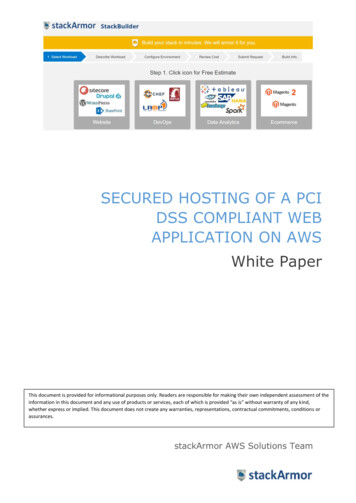


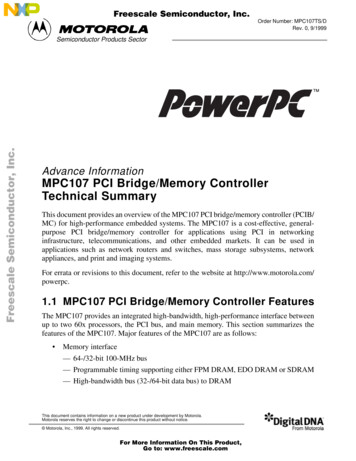
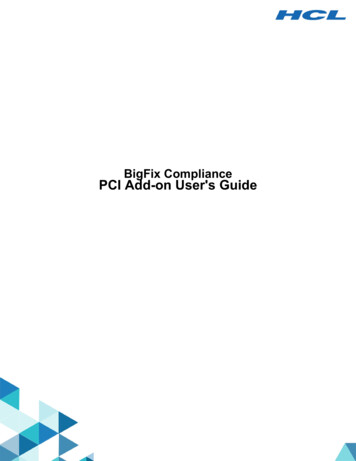
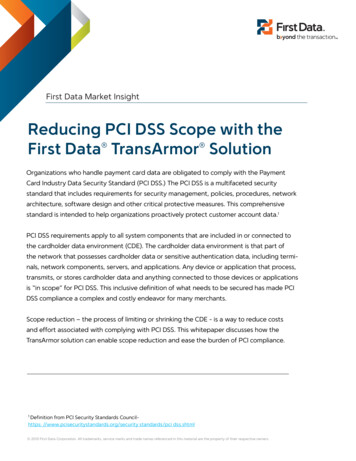
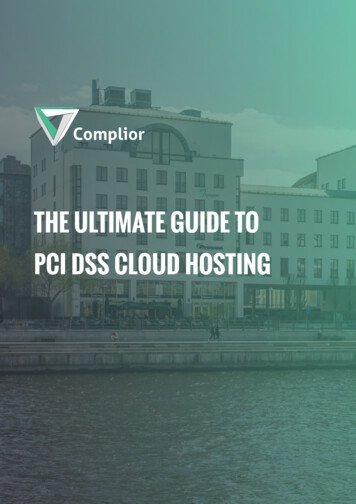
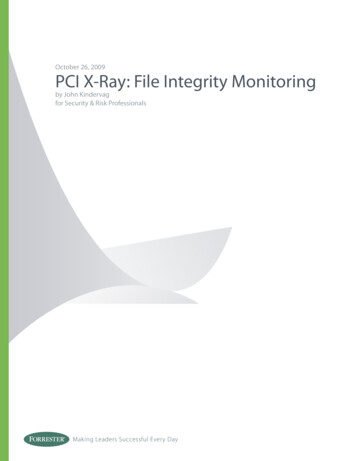
![PCI Compliant - but are we secure -- FOR PRINTING IN GRAYSCALE [Read-Only]](/img/14/303-pci-3.jpg)
